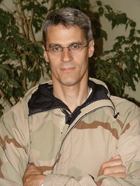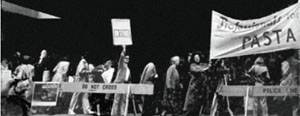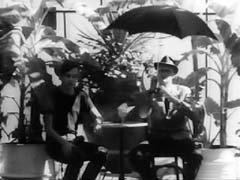Audio of Jakob Boeskov talk for the conference
THE EXPANDED NOTION OF PUBLIC ART
The Royal Danish Art Academy
Copenhagen
November 8, 2005
murphy's blog
Jakob Boeskov on Public Art
David Cronenberg Interview on Warhol
From twhid at MTAA-RR
A great Rocketboom today
An interview with David Cronenberg on the opening of his curatorial effort, “Andy Warhol/Supernova: Stars, Deaths and Disasters, 1962-1964” at the Art Gallery of Ontario.
Artists in Antarctica
calendarlive.com: Fleeting Albuquerque heavens in Antarctica
Fleeting Albuquerque heavens in AntarcticaThe L.A. artist's team will map `Stellar Axis' and then take it apart, thanks to a U.S. grant.
Open Source Culture: Resource File
Open Source Culture
Filez
http://nothing.org/osc/filez.htm
Berenson, Frederick. "The
darkside of the :Cuecat." OpenOffice.org/PowerPoint Presentation.
Art Junction. "Copyright and Appropriation
Web Quest: Deciding the Fate of Sherrie Levine". Also available at
http://www.artjunction.org/projects/levine_on_trial
A Critical History of 20th-Century Art: Minimalism and Pop
OF 20TH-CENTURY ART
Chapter 7, Parts 1, 2 & 3: The Appeal of Popularity, Ideology and Theory: The Objectification of Art and the Abortive Protest of the Subject: The Seventh Decade
On the one side, Donald Judd, Frank Stella and Andy Warhol, on the other side Eva Hesse, Robert Smithson and Joseph Beuys, to elevate to exemplary status only a few of the many artists working on opposites sides of the great divide -- the brutal dialectic -- of ‘60s art. For the former, the work of art is a "specific object," to use Judd’s famous term. For the latter, the work of art is the expressive byproduct of a "therapeutic process," to use Beuys’ important idea. On the one hand, there is the use of "real materials in real space" to construct "an object" which is "the whole idea without any confusion," to use Stella’s words. "Confusion" is caused by social and subjective import. As Stella writes, "only what can be seen there is there." This statement resembles Warhol’s remark -- it was made about the same time, and with the same smug coolness -- that "there’s nothing behind. . . the surface of my paintings and films and me." This is usually understood to be ironical, but it is, in fact, an honest acknowledgement of the lack of depth in all three artists.
Music Video Art On the River, Heizer, Soutine etc.

Charles Atlas, You Are My Sister
Electric Arts Intermix showed free music videos under the stars last night on Pier 63 on the Hudson River in New York.
William Wegman's 1988 video for New Order, Blue Monday reminded me once again that a little Wegman goes a long way and the same can be said for the Tony Ousler/Sonic Youth collaboration, Tunic from 1990. Is it just me or have SY been playing the same song with varying degrees of volumn and speed for the past twenty years?
NY Review of Books: The Threat to the Planet

At left, a satellite image showing Florida at present; at right, a projection of what Florida will look like if the sea level increases by 18-20 feet
The Threat to the Planet
By Jim Hansen
http://www.nybooks.com/articles/19131
Animals are on the run. Plants are migrating too. The Earth's creatures, save for one species, do not have thermostats in their living rooms that they can adjust for an optimum environment. Animals and plants are adapted to specific climate zones, and they can survive only when they are in those zones. Indeed, scientists often define climate zones by the vegetation and animal life that they support. Gardeners and bird watchers are well aware of this, and their handbooks contain maps of the zones in which a tree or flower can survive and the range of each bird species. Those maps will have to be redrawn. Most people, mainly aware of larger day-to-day fluctuations in the weather, barely notice that climate, the average weather, is changing.
Presidential Art Critic

Karl Zinsmeister
President Bush's new chief domestic policy adviser, Karl Zinsmeister, writes about art:
When Art Becomes Inhuman
Karl Zinsmeister
"There are post-modernist works featured in this article that some may find disturbing. Our sole intention in including these works has been to illustrate the aesthetic and moral 'values' championed by the contemporary art establishment. We do not endorse these self-proclaimed 'artists'."
http://www.artrenewal.org/articles/2002/Art_Inhuman/inhuman1.asp
Dark Matter, Gregory Sholette

Art Workers Coalition join striking workers at the
Museum of Modern Art, NYC (from an ArtForum cover, 1973)
DARK MATTER: Activist Art and the Counter-Public Sphere (2003)
Gregory Sholette
http://gregorysholette.com
Download the pdf:
http://gregorysholette.com/essays/docs/05_darkmattertwo.pdf
Abstract:
The central question this essay raises is this: how might a critical, materialist analysis of visual culture be enhanced by factoring in what I term creative dark matter? It is my contention that the majority of creative activity in our post-industrial society remains invisible to the institutions and discourses — critics, art historians, collectors, dealers, museums, curators and arts administrators — who manage and interpret contemporary culture. My central argument however seeks to relate this creative Dark Matter to the practices of artists who self-consciously work outside the parameters of the mainstream art world for political and socially critical reasons. Among the latter include the art-based organizations Temporary Services, RTmark, REPOhistory and Ultra Red as well as several others that will serve as examples of alternative artistic forms throughout my paper. These informal, politicized micro-institutions have made art that infiltrates high schools, flea markets, public squares, corporate Web Sites, city streets, housing projects, and local political machines in ways that do not set out to recover a specific meaning or use-value for either art world discourse or private interests. It is the emergence of these autonomous groups of activist artists into a broader visual arena, one where they become visible not only to each other but also to the centralized institutions of the art world, that presents new possibilities for critical resistance, as well as traps and opportunities for self-delusion.
